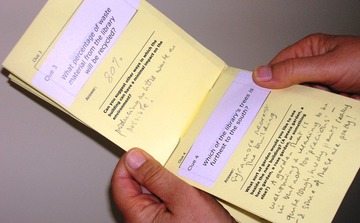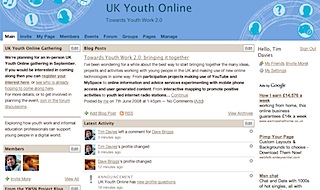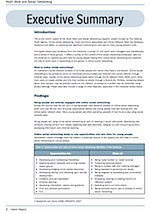 Over at the newly arrived 2gether08 website Steve Bridger has been musing about what Fair Trade 2.0 might look like.
Over at the newly arrived 2gether08 website Steve Bridger has been musing about what Fair Trade 2.0 might look like.
The FAIRTRADE Mark changes peoples behavior by giving them information about the products they are buying. When you buy a product with a FAIRTRADE Mark on you know that the producer has been paid a fair price for their work, alongside a social premium to be invested in development projects in their community. But the Fair Trade movement is not just about changing people's buying decisions in the abstract – it is also about re-forging the connections between producer and consumer that get lost in a globalised market-driven world.
Whilst my jar of Fairtrade Coffee might provide me with a story about one of the producers involved in the co-op that made it – the social web could do a lot more – and that could bring on Fair Trade 2.0.
What might Fair Trade 2.0 look like?
1) Producer Stories
The short quote from Daniel Minaya Huaman on the back of my jar of Cafe Direct is great – but to really know where my coffee comes from – what if every producer was offering the sort of stories that I can find at From Crop 2 Cup?
Of course, you might ask just how many people are really going to go any look up all the items in their shopping basket online? When I was working for Just Fair Trade in Leicester we explored options for moving to an electronic point of sale system that would print information about the producers on customers receipts. If the stories were there – we would have been able to give customers a far stronger connection with the producer of the products they were buying.
2) Seeing the whole supply chain
 Right now the FAIRTRADE Mark tells me about the original commodity producer – but it doesn't tell me the whole story. For example, I don't know the conditions in which the Fairtrade Cotton trousers I bought from M&S the other day were made – and whilst I know that the farmer of the coffee I'm drinking got more for her work that she would have selling a non-fair trade product – I don't know how much of the money went to the farmer.
Right now the FAIRTRADE Mark tells me about the original commodity producer – but it doesn't tell me the whole story. For example, I don't know the conditions in which the Fairtrade Cotton trousers I bought from M&S the other day were made – and whilst I know that the farmer of the coffee I'm drinking got more for her work that she would have selling a non-fair trade product – I don't know how much of the money went to the farmer.
That's one of the issues that projects like FairTracing are seeking to address – tracking and laying the whole supply chain open to see in Web 2.0 ways. Try this prototype for example.
Or when it comes to an audit trail – what about this system from coffee path that shows all the documentation from along the supply chain.
3) Better decision making information
 Ever since I first saw the Corporate Fallout Detector I've been curious about the simple ways in which information about the ethics of a product can be presented to people at point of sale in a straightforward way.
Ever since I first saw the Corporate Fallout Detector I've been curious about the simple ways in which information about the ethics of a product can be presented to people at point of sale in a straightforward way.
There are two challenges:
a) The space available on packaging can make it tricky to present enough information to people when they are choosing between products. Often the information gets reduced to product marks (Organic, Fairtrade, Non-air-freight) from certifying bodies. But my ethical views may not be fully captured by the certifying marks available.
b) Even when I can get all the information I want about a product, the cognitive load of calculating and comparing products is often simply too much (I find myself wanting to go back to a simple certifying mark of some sort).
Improving decision making in Fair trade 2.0 could go a number of directions. It could go the Wiki-way being explored by WIBI.IT or we could find more advanced versions of the Ethiscore and Gooshing ideas that make it easy to order products according to your own ethical beliefs – as well as according to pre-set values.
4) Making connections
All the ideas above are about getting better Fair Trade information for the customer. But social media also presents massive potential opportunities for actual dis-intermediated connection between producer and consumer. As internet connectivity becomes more ubiquitous on the supply side – could I find myself following my coffee grower in Twitter, and competing in an eBay auction for a premium supply of chocolate beans? Could I be setting up a live chat with a grower, rather than just showing a slide-show when encouraging my workplace to switch to Fair Trade? The two-way role of social media in the future of fair trade is not something I've not yet given much thinking time to… but perhaps this is where the future really lies. The technology creates the connection… and then it can almost get out of the way…
5) What else?
What do you think lies in the future of Fair Trade? What will social media transform? What are the challenges ahead. I'm sure Steve would appreciate your comments over on the 2gether site – and I'd certainly welcome any reflections here…
Corporate Fallout Detector image from: http://www.jamespatten.com/cfd/
 Thanks to Nick Booth for a pointer to this website where you can see which of the 198 National Indicators that central government sets for Local Authorities your council has chosen to focus on. Local Authorities have each had to choose 35 priority indicators that their performance will be measured against.
Thanks to Nick Booth for a pointer to this website where you can see which of the 198 National Indicators that central government sets for Local Authorities your council has chosen to focus on. Local Authorities have each had to choose 35 priority indicators that their performance will be measured against.  Kevin combined a quiz-book based treasure hunt around the site of the library due to be redeveloped with opportunities to speak to architects, chances to
Kevin combined a quiz-book based treasure hunt around the site of the library due to be redeveloped with opportunities to speak to architects, chances to 
 I've been looking for a while for a space where all the conversations around work with young people and new technologies/social media/web 2.0 can come together.
I've been looking for a while for a space where all the conversations around work with young people and new technologies/social media/web 2.0 can come together.
 Just a quick pointer to the
Just a quick pointer to the  Over at the newly arrived 2gether08 website
Over at the newly arrived 2gether08 website 
 Right now the FAIRTRADE Mark tells me about the original commodity producer – but it doesn't tell me the whole story. For example, I don't know the conditions in which the Fairtrade Cotton trousers I bought from M&S the other day were made – and whilst I know that the farmer of the coffee I'm drinking got more for her work that she would have selling a non-fair trade product – I don't know how much of the money went to the farmer.
Right now the FAIRTRADE Mark tells me about the original commodity producer – but it doesn't tell me the whole story. For example, I don't know the conditions in which the Fairtrade Cotton trousers I bought from M&S the other day were made – and whilst I know that the farmer of the coffee I'm drinking got more for her work that she would have selling a non-fair trade product – I don't know how much of the money went to the farmer.  Ever since I first saw the
Ever since I first saw the  On Friday Ofcom published their
On Friday Ofcom published their  As if annually taking on a stage of the Tour de France hasn't been enough, this year, in celebration of his 50th Birthday,
As if annually taking on a stage of the Tour de France hasn't been enough, this year, in celebration of his 50th Birthday,